Effect of Ball Inclusion in Drop Vertical Jump Test on Performance and Movement Variability in Basketball Players
Abstract
:1. Introduction
2. Materials and Methods
2.1. Participants
2.2. Study Design
2.3. Equipment
2.4. Data Analysis
2.5. Data Collection
2.6. Statistical Analysis
3. Results
4. Discussion
5. Conclusions
6. Practical Application
Author Contributions
Funding
Institutional Review Board Statement
Informed Consent Statement
Data Availability Statement
Acknowledgments
Conflicts of Interest
References
- Reina, M.; García-Rubio, J.; Ibáñez, S.J. Training and competition load in female basketball: A systematic review. Int. J. Environ. Res. Public Health 2020, 17, 2639. [Google Scholar] [CrossRef] [PubMed]
- Ben Abdelkrim, N.; El Fazaa, S.; El Ati, J. Time–motion analysis and physiological data of elite under-19-year-old basketball players during competition. Br. J. Sports Med. 2007, 41, 69–75. [Google Scholar] [CrossRef] [PubMed]
- Gottlieb, R.; Shalom, A.; Calleja-Gonzalez, J. Physiology of Basketball–Field Tests. Review Article. J. Hum. Kinet. 2021, 77, 159–167. [Google Scholar] [CrossRef] [PubMed]
- Meckel, Y.; Gottlieb, R.; Eliakim, A. Repeated sprint tests in young basketball players at different game stages. Eur. J. Appl. Physiol. 2009, 107, 273–279. [Google Scholar] [CrossRef] [PubMed]
- Caparrós, T.; Casals, M.; Solana, Á.; Peña, J. Low external workloads are related to higher injury risk in professional male basketball games. J. Sports Sci. Med. 2018, 17, 289. [Google Scholar] [PubMed]
- Häkkinen, K. Force production characteristics of leg extensor, trunk flexor and extensor muscles in male and female basketball players. J. Sports Med. Phys. Fitness 1991, 31, 325–331. [Google Scholar] [PubMed]
- Hewit, J.K.; Cronin, J.B.; Hume, P.A. Asymmetry in multi-directional jumping tasks. Phys. Ther. Sport 2012, 13, 238–242. [Google Scholar] [CrossRef]
- Ziv, G.; Lidor, R. Vertical jump in female and male basketball players—A review of observational and experimental studies. J. Sci. Med. Sport 2010, 13, 332–339. [Google Scholar] [CrossRef]
- Alba-Jiménez, C.; Moreno-Doutres, D.; Peña, J. Trends assessing neuromuscular fatigue in team sports: A narrative review. Sports 2022, 10, 33. [Google Scholar] [CrossRef]
- Legg, J.; Pyne, D.B.; Semple, S.; Ball, N. Variability of jump kinetics related to training load in elite female basketball. Sports 2017, 5, 85. [Google Scholar] [CrossRef]
- Ostojic, S.M.; Mazic, S.; Dikic, N. Profiling in basketball: Physical and physiological characteristics of elite players. J. strength Cond. Res. 2006, 20, 740. [Google Scholar] [CrossRef] [PubMed]
- Rodríguez-Rosell, D.; Mora-Custodio, R.; Franco-Márquez, F.; Yáñez-García, J.M.; González-Badillo, J.J. Traditional vs. sport-specific vertical jump tests: Reliability, validity, and relationship with the legs strength and sprint performance in adult and teen soccer and basketball players. J. Strength Cond. Res. 2017, 31, 196–206. [Google Scholar] [CrossRef] [PubMed]
- Cabarkapa, D.; Philipp, N.; Cabarkapa, D.; Eserhaut, D.; Fry, A. Comparison of Force-Time Metrics Between Countermovement Vertical Jump with and without an Arm Swing in Professional Male Basketball Players. Int. J. Strength Cond. 2023, 3. [Google Scholar] [CrossRef]
- Burr, J.F.; Jamnik, V.K.; Dogra, S.; Gledhill, N. Evaluation of jump protocols to assess leg power and predict hockey playing potential. J. Strength Cond. Res. 2007, 21, 1139–1145. [Google Scholar] [PubMed]
- Travassos, B.; Araújo, D.; Vilar, L.; McGarry, T. Interpersonal coordination and ball dynamics in futsal (indoor football). Hum. Mov. Sci. 2011, 30, 1245–1259. [Google Scholar] [CrossRef]
- Fernández-Valdés, B.; Sampaio, J.; Exel, J.; González, J.; Tous-Fajardo, J.; Jones, B.; Moras, G. The influence of functional flywheel resistance training on movement variability and movement velocity in elite rugby players. Front. Psychol. 2020, 11, 1205. [Google Scholar] [CrossRef] [PubMed]
- Moras, G.; Fernández-Valdés, B.; Vázquez-Guerrero, J.; Tous-Fajardo, J.; Exel, J.; Sampaio, J. Entropy measures detect increased movement variability in resistance training when elite rugby players use the ball. J. Sci. Med. Sport 2018, 21, 1286–1292. [Google Scholar] [CrossRef]
- Virgile, A.; Bishop, C. A narrative review of limb dominance: Task specificity and the importance of fitness testing. J. Strength Cond. Res. 2021, 35, 846–858. [Google Scholar] [CrossRef]
- Bishop, C. Inter-Limb Asymmetry: Longitudinal Monitoring and Associations with Speed and Change of Direction Speed in Elite Academy Soccer Players. Ph.D. Thesis, Middlesex University, London, UK, 2020. [Google Scholar]
- Jamkrajang, P.; Mongkolpichayaruk, A.; Limroongreungrat, W.; Wiltshire, H.; Irwin, G. The effect of arm dominance on knee joint biomechanics during basketball block shot single-leg landing. J. Hum. Kinet. 2022, 83, 13–21. [Google Scholar] [CrossRef]
- Schnittjer, A.; Simon, J.E.; Yom, J.; Grooms, D.R. The effects of a cognitive dual task on jump-landing movement quality. Int. J. Sports Med. 2021, 42, 90–95. [Google Scholar] [CrossRef]
- Caparrós, T.; Peña, J.; Baiget, E.; Borràs-Boix, X.; Calleja-Gonzalez, J.; Rodas, G. Influence of Strength Programs on the Injury Rate and Team Performance of a Professional Basketball Team: A Six-Season Follow-Up Study. Front. Psychol. 2022, 12, 796098. [Google Scholar] [CrossRef] [PubMed]
- Wilkerson, G.B. Neurocognitive reaction time predicts lower extremity sprains and strains. Int. J. Athl. Ther. Train. 2012, 17, 4–9. [Google Scholar] [CrossRef]
- Zamankhanpour, M.; Sheikhhoseini, R.; Letafatkar, A.; Piri, H.; Asadi Melerdi, S.; Abdollahi, S. The effect of dual-task on jump landing kinematics and kinetics in female athletes with or without dynamic knee valgus. Sci. Rep. 2023, 13, 14305. [Google Scholar] [CrossRef] [PubMed]
- Imai, S.; Harato, K.; Morishige, Y.; Kobayashi, S.; Niki, Y.; Sato, K.; Nagura, T. Effects of dual task interference on biomechanics of the entire lower extremity during the drop vertical jump. J. Hum. Kinet. 2022, 81, 5–14. [Google Scholar] [CrossRef] [PubMed]
- Akbari, H.; Kuwano, S.; Shimokochi, Y. Effect of heading a soccer ball as an external focus during a drop vertical jump task. Orthop. J. Sports Med. 2023, 11, 23259671231164704. [Google Scholar]
- Cowin, J.; Nimphius, S.; Fell, J.; Culhane, P.; Schmidt, M. A proposed framework to describe movement variability within sporting tasks: A scoping review. Sports Med. 2022, 8, 85. [Google Scholar] [CrossRef]
- Davids, K.; Glazier, P.; Araújo, D.; Bartlett, R. Movement systems as dynamical systems: The functional role of variability and its implications for sports medicine. Sports Med. 2003, 33, 245–260. [Google Scholar] [CrossRef]
- Lipsitz, L.A.; Goldberger, A.L. Loss of ‘complexity’ and aging: Potential applications of fractals and chaos theory to senescence. JAMA 1992, 267, 1806–1809. [Google Scholar] [CrossRef]
- Rhea, C.K.; Silver, T.A.; Hong, S.L.; Ryu, J.H.; Studenka, B.E.; Hughes, C.M.L.; Haddad, J.M. Noise and complexity in human postural control: Interpreting the different estimations of entropy. PLoS ONE 2011, 6, e17696. [Google Scholar] [CrossRef]
- Lubetzky, A.V.; Harel, D.; Lubetzky, E. On the effects of signal processing on sample entropy for postural control. PLoS ONE 2018, 13, e0193460. [Google Scholar] [CrossRef]
- Murray, A.M.; Ryu, J.H.; Sproule, J.; Turner, A.P.; Graham-Smith, P.; Cardinale, M. A Pilot Study Using Entropy as a Non-Invasive Assessment of Running. Int. J. Sports Physiol. Perform. 2017, 12, 1119–1122. [Google Scholar] [CrossRef]
- Moras, G.; Vázquez-Guerrero, J.; Fernández-Valdés, B.; Rosas-Casals, M.; Weakley, J.; Jones, B.; Sampaio, J. Structure of force variability during squats performed with an inertial flywheel device under stable versus unstable surfaces. Hum. Mov. Sci. 2019, 66, 497–503. [Google Scholar] [CrossRef] [PubMed]
- Tuyà Viñas, S.; Fernández-Valdés Villa, B.; Pérez-Chirinos Buxadé, C.; Morral-Yepes, M.; del Campo Montoliu, L.; Moras Feliu, G. Adding mechanical vibration to a half squat with different ballasts and rhythms increases movement variability. PLoS ONE 2023, 18, e0284863. [Google Scholar] [CrossRef] [PubMed]
- Pérez-Chirinos, C.; Padullés, J.M.; Gavaldà, D.; Trabucchi, M.; Fernández-Valdés, B.; Tuyà Viñas, S.; Moras, G. Movement variability and performance of elite alpine skiers descending different slalom course settings. In Proceedings of the 9th International Congress on Science and Skiing, Saalbach-Hinterglemm, Austria, 18–22 March 2023; University of Salzburg: Salzburg, Austria, 2023; p. 22. [Google Scholar]
- Almonroeder, T.G.; Kernozek, T.; Cobb, S.; Slavens, B.; Wang, J.; Huddleston, W. Cognitive demands influence lower extremity mechanics during a drop vertical jump task in female athletes. J. Orthop. Sports Phys. Ther. 2018, 48, 381–387. [Google Scholar] [CrossRef] [PubMed]
- Holmes, H.H.; Talmage, J.L.D.; Neely, K.A.; Roper, J.A. Cognitive Demands Influence Drop Jump Performance and Relationships with Leg Stiffness in Healthy Young Adults. J. Strength Cond. Res. 2022, 37, 74–83. [Google Scholar] [CrossRef]
- Viñas, S.T.; Villa, B.F.-V.; Buxadé, C.P.-C.; González, J.; Feliu, G.M. Decision making influences movement variability and performance of high-level female football players in an elastic resistance task. Front. Psychol. 2023, 14, 1175248. [Google Scholar] [CrossRef]
- Loturco, I.; Pereira, L.A.; Kobal, R.; Abad, C.C.C.; Rosseti, M.; Carpes, F.P.; Bishop, C. Do asymmetry scores influence speed and power performance in elite female soccer players? Biol. Sport 2019, 36, 209–216. [Google Scholar] [CrossRef]
- Heishman, A.; Daub, B.; Miller, R.; Brown, B.; Freitas, E.; Bemben, M. Countermovement Jump Inter-Limb Asymmetries in Collegiate Basketball Players. Sports 2019, 7, 103. [Google Scholar] [CrossRef]
- Saper, M.G.; Fantozzi, P.; Bompadre, V.; Racicot, M.; Schmale, G.A. Return-to-Sport Testing after Medial Patellofemoral Ligament Reconstruction in Adolescent Athletes. Orthop. J. Sports Med. 2019, 7, 2325967119828953. [Google Scholar] [CrossRef]
- Maleki-Ghahfarokhi, A.; Dianat, I.; Feizi, H.; Asghari -Jafarabadi, M. Influences of gender, hand dominance, and anthropometric characteristics on different types of pinch strength: A partial least squares (PLS) approach. Appl. Ergon. 2019, 79, 9–16. [Google Scholar] [CrossRef]
- van Melick, N.; Meddeler, B.M.; Hoogeboom, T.J.; Nijhuis-van der Sanden, M.W.G.; van Cingel, R.E.H. How to determine leg dominance: The agreement between self-reported and observed performance in healthy adults. PLoS ONE 2017, 12, e0189876. [Google Scholar] [CrossRef] [PubMed]
- Pérez-Chirinos Buxadé, C.; Fernández-Valdés, B.; Morral-Yepes, M.; Tuyà Viñas, S.; Padullés Riu, J.M.; Moras Feliu, G. Validity of a Magnet-Based Timing System Using the Magnetometer Built into an IMU. Sensors 2021, 21, 5773. [Google Scholar] [CrossRef] [PubMed]
- Montgomery, P.; Pyne, D.; Minahan, C. The Physical and Physiological Demands of Basketball Training and Competition. Int. J. Sports Physiol. Perform. 2010, 5, 75–86. [Google Scholar] [CrossRef] [PubMed]
- Kirby, T.J.; McBride, J.M.; Haines, T.L.; Dayne, A.M. Relative net vertical impulse determines jumping performance. J. Appl. Biomech. 2011, 27, 207–214. [Google Scholar] [CrossRef] [PubMed]
- Gomez-Carmona, C.D.; Bastida-Castillo, A.; García-Rubio, J.; Ibáñez, S.J.; Pino-Ortega, J. Static and dynamic reliability of WIMU PROTM accelerometers according to anatomical placement. Proc. Inst. Mech. Eng. Part P J. Sport. Eng. Technol. 2019, 233, 238–248. [Google Scholar]
- Goldberger, A.L.; Amaral, L.A.N.; Glass, L.; Hausdorff, J.M.; Ivanov, P.C.; Mark, R.G.; Mietus, J.E.; Moody, G.B.; Peng, C.-K.; Stanley, H.E. PhysioBank, PhysioToolkit, and PhysioNet: Components of a new research resource for complex physiologic signals. Circulation 2000, 101, e215–e220. [Google Scholar] [CrossRef]
- Bishop, C.; Read, P.; Lake, J.; Chavda, S.; Turner, A. Interlimb asymmetries: Understanding how to calculate differences from bilateral and unilateral tests. Strength Cond. J. 2018, 40, 1–6. [Google Scholar] [CrossRef]
- Bishop, C.; Read, P.; McCubbine, J.; Turner, A. Vertical and horizontal asymmetries are related to slower sprinting and jump performance in elite youth female soccer players. J. Strength Cond. Res. 2021, 35, 56–63. [Google Scholar] [CrossRef]
- Bonato, M.; Benis, R.; La Torre, A. Neuromuscular training reduces lower limb injuries in elite female basketball players. A cluster randomized controlled trial. Scand. J. Med. Sci. Sports 2018, 28, 1451–1460. [Google Scholar] [CrossRef]
- Lin, J.-Z.; Tai, W.-H.; Chiu, L.-Y.; Lin, Y.-A.; Lee, H.-J. The effect of divided attention with bounce drop jump on dynamic postural stability. Int. J. Sports Med. 2020, 41, 776–782. [Google Scholar]
- Hopkins, W.G.; Marshall, S.W.; Batterham, A.M.; Hanin, J. Progressive statistics for studies in sports medicine and exercise science. Med. Sci. Sports Exerc. 2009, 41, 3–12. [Google Scholar] [CrossRef] [PubMed]
- Bishop, C.; Turner, A.; Jarvis, P.; Chavda, S.; Read, P. Considerations for selecting field-based strength and power fitness tests to measure asymmetries. J. Strength Cond. Res. 2017, 31, 2635–2644. [Google Scholar] [CrossRef] [PubMed]
- McGarry, T.I.M.; Khan, M.A.; Franks, I.M. On the presence and absence of behavioural traits in sport: An example from championship squash match-play. J. Sports Sci. 1999, 17, 297–311. [Google Scholar] [CrossRef] [PubMed]
- Newell, K.M.; Kugler, P.N.; Van Emmerik, R.E.A.; McDonald, P.V. Search strategies and the acquisition of coordination. In Advances in Psychology; Elsevier: Amsterdam, The Netherlands, 1989; Volume 61, pp. 85–122. ISBN 0166-4115. [Google Scholar]
- Fischer, P.D.; Hutchison, K.A.; Becker, J.N.; Monfort, S.M. Evaluating the spectrum of cognitive-motor relationships during dual-task jump landing. J. Appl. Biomech. 2021, 37, 388–395. [Google Scholar] [CrossRef] [PubMed]
- Beardt, B.S.; McCollum, M.R.; Hinshaw, T.J.; Layer, J.S.; Wilson, M.A.; Zhu, Q.; Dai, B. Lower-extremity kinematics differed between a controlled drop-jump and volleyball-takeoffs. J. Appl. Biomech. 2018, 34, 327–335. [Google Scholar] [CrossRef] [PubMed]
- Fílter, A.; Olivares Jabalera, J.; Molina-Molina, A.; Suárez-Arrones, L.; Robles-Rodríguez, J.; Dos’ Santos, T.; Loturco, I.; Requena, B.; Santalla, A. Effect of ball inclusion on jump performance in soccer players: A biomechanical approach. Sci. Med. Footb. 2022, 6, 241–247. [Google Scholar] [CrossRef]
- Stone, J.A.; Maynard, I.W.; North, J.S.; Panchuk, D.; Davids, K. (De) synchronization of advanced visual information and ball flight characteristics constrains emergent information–movement couplings during one-handed catching. Exp. Brain Res. 2015, 233, 449–458. [Google Scholar] [CrossRef]
- Loturco, I.; Pereira, L.A.; Kobal, R.; Cal Abad, C.C.; Fernandes, V.; Ramirez-Campillo, R.; Suchomel, T. Portable force plates: A viable and practical alternative to rapidly and accurately monitor elite sprint performance. Sports 2018, 6, 61. [Google Scholar] [CrossRef]
- Kyritsis, P.; Bahr, R.; Landreau, P.; Miladi, R.; Witvrouw, E. Likelihood of ACL graft rupture: Not meeting six clinical discharge criteria before return to sport is associated with a four times greater risk of rupture. Br. J. Sports Med. 2016, 50, 946–951. [Google Scholar] [CrossRef]
- van Emmerik, R.E.A.; van Wegen, E.E.H. On the functional aspects of variability in postural control. Exerc. Sport Sci. Rev. 2002, 30, 177–183. [Google Scholar] [CrossRef]
- Button, C.; Davids, K.; Schollhorn, W.I. Coordination Profiling of Movement Systems; Davids, K., Bennett, S., Newell, K., Eds.; Human Kinetics: Champaign, IL, USA, 2006. [Google Scholar]
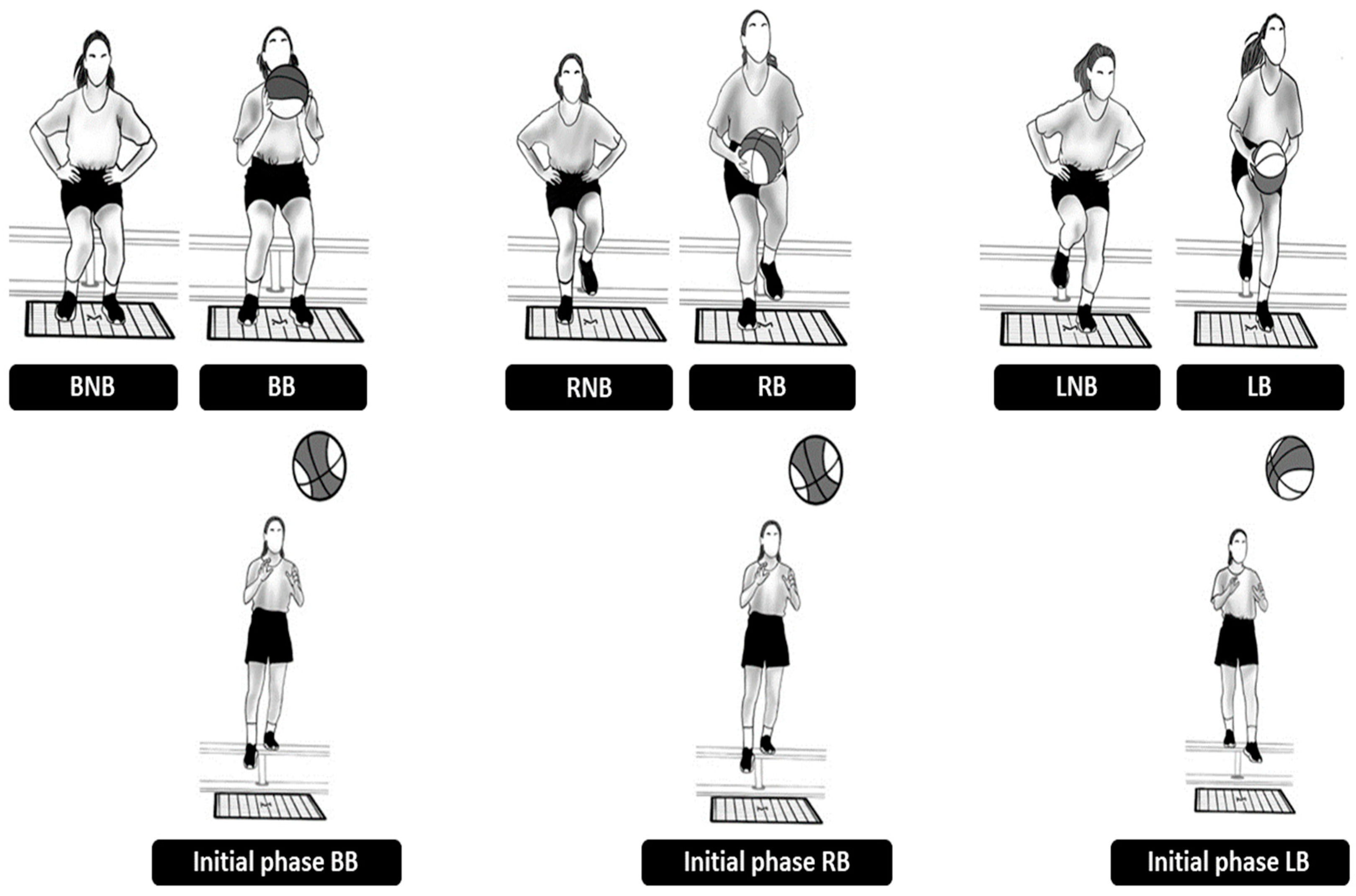
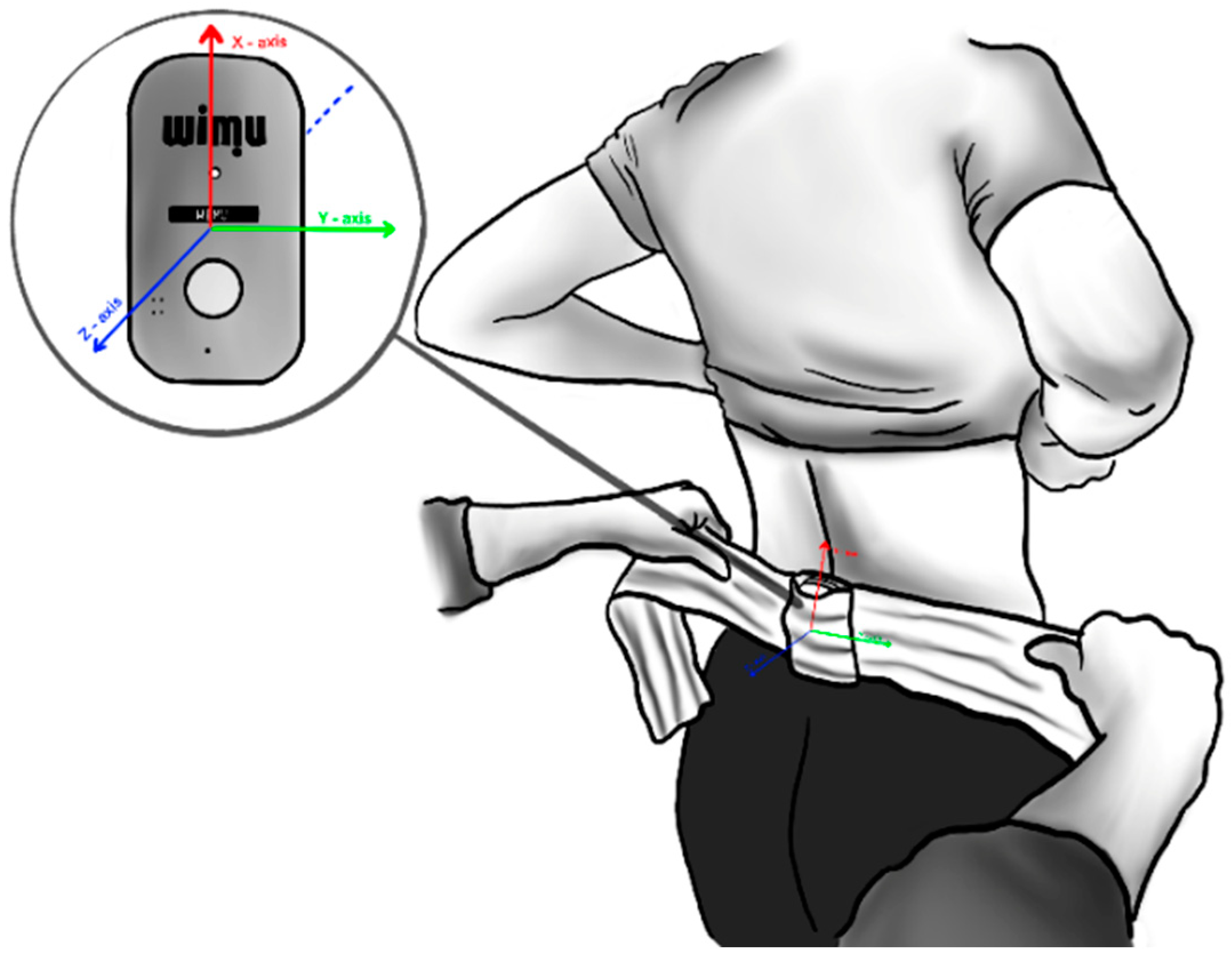


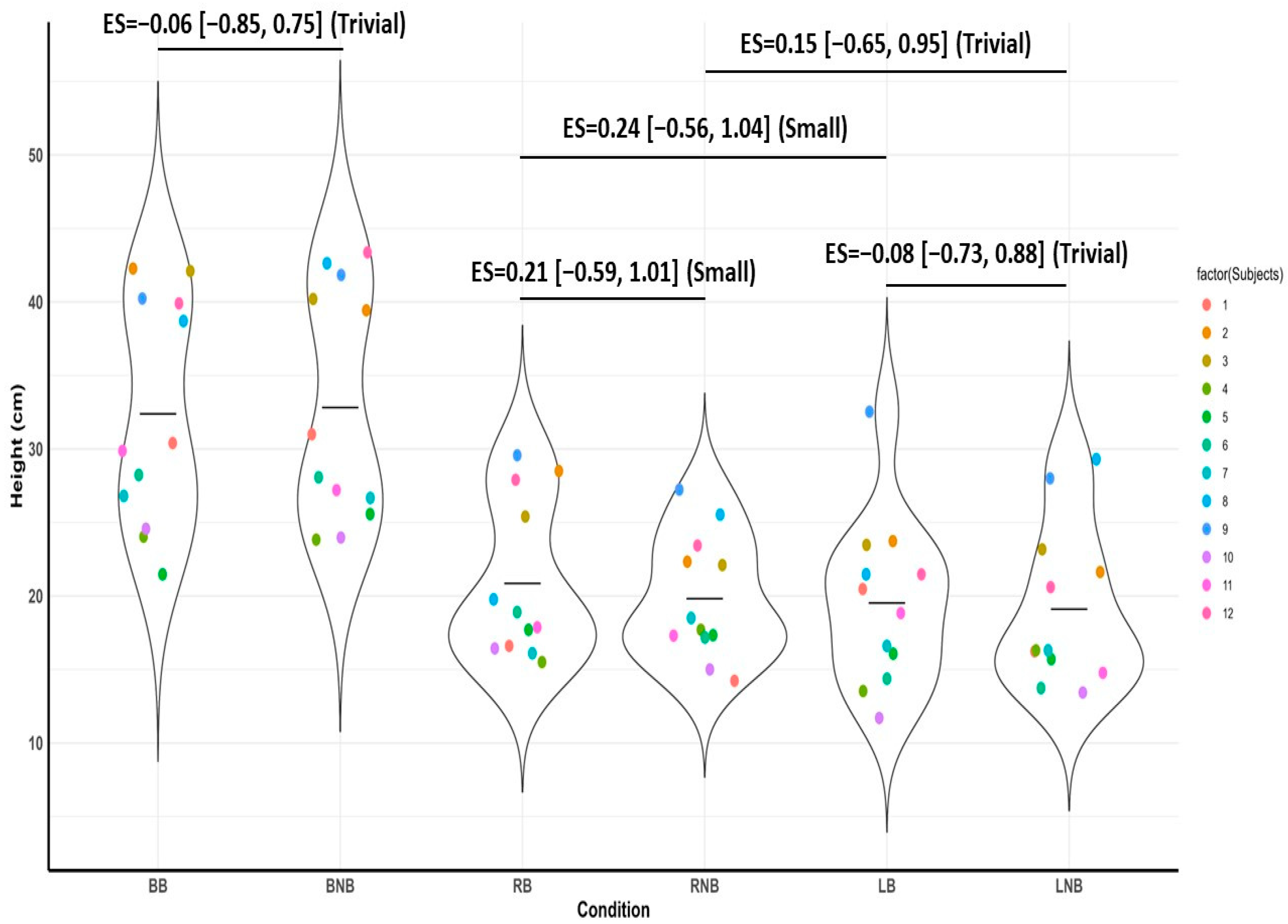
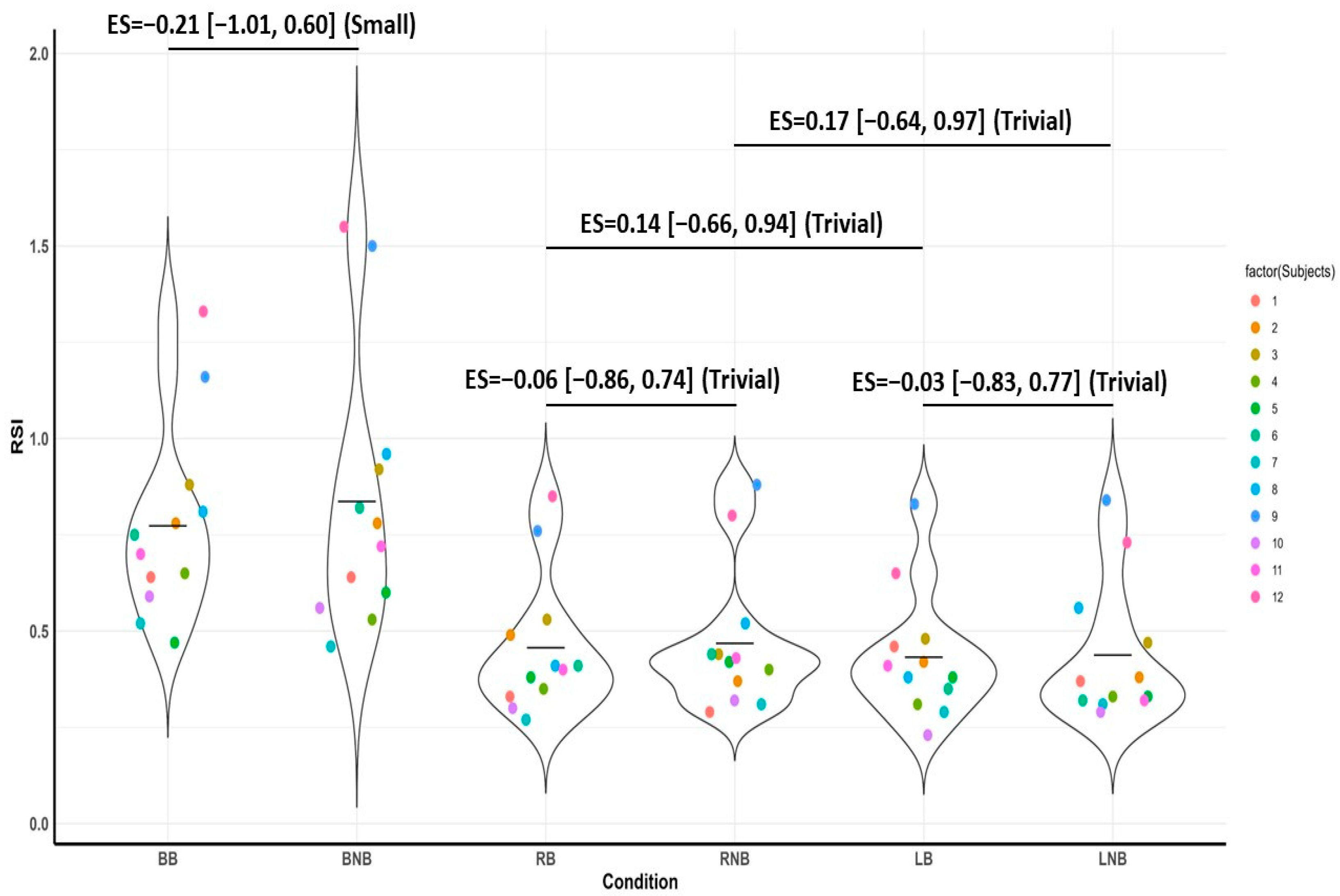

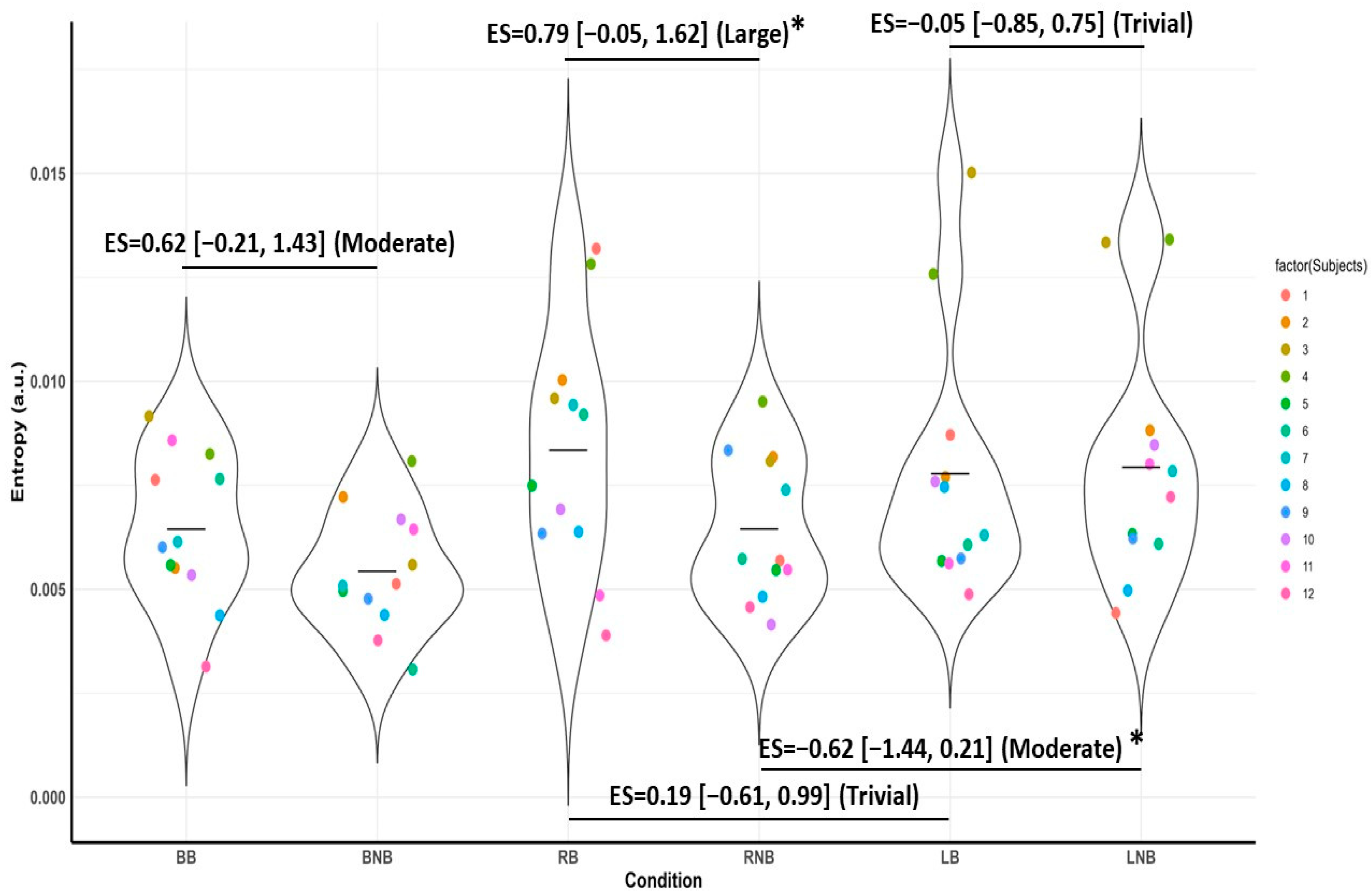

Disclaimer/Publisher’s Note: The statements, opinions and data contained in all publications are solely those of the individual author(s) and contributor(s) and not of MDPI and/or the editor(s). MDPI and/or the editor(s) disclaim responsibility for any injury to people or property resulting from any ideas, methods, instructions or products referred to in the content. |
© 2024 by the authors. Licensee MDPI, Basel, Switzerland. This article is an open access article distributed under the terms and conditions of the Creative Commons Attribution (CC BY) license (https://creativecommons.org/licenses/by/4.0/).
Share and Cite
González-Millán, S.; Caparrós, T.; Toro-Román, V.; Illera-Domínguez, V.; Albesa-Albiol, L.; Moras, G.; Pérez-Chirinos Buxadé, C.; Fernández-Valdés, B. Effect of Ball Inclusion in Drop Vertical Jump Test on Performance and Movement Variability in Basketball Players. Appl. Sci. 2024, 14, 505. https://doi.org/10.3390/app14020505
González-Millán S, Caparrós T, Toro-Román V, Illera-Domínguez V, Albesa-Albiol L, Moras G, Pérez-Chirinos Buxadé C, Fernández-Valdés B. Effect of Ball Inclusion in Drop Vertical Jump Test on Performance and Movement Variability in Basketball Players. Applied Sciences. 2024; 14(2):505. https://doi.org/10.3390/app14020505
Chicago/Turabian StyleGonzález-Millán, Sara, Toni Caparrós, Víctor Toro-Román, Víctor Illera-Domínguez, Lluís Albesa-Albiol, Gerard Moras, Carla Pérez-Chirinos Buxadé, and Bruno Fernández-Valdés. 2024. "Effect of Ball Inclusion in Drop Vertical Jump Test on Performance and Movement Variability in Basketball Players" Applied Sciences 14, no. 2: 505. https://doi.org/10.3390/app14020505
APA StyleGonzález-Millán, S., Caparrós, T., Toro-Román, V., Illera-Domínguez, V., Albesa-Albiol, L., Moras, G., Pérez-Chirinos Buxadé, C., & Fernández-Valdés, B. (2024). Effect of Ball Inclusion in Drop Vertical Jump Test on Performance and Movement Variability in Basketball Players. Applied Sciences, 14(2), 505. https://doi.org/10.3390/app14020505








